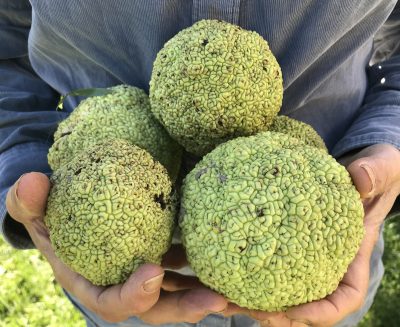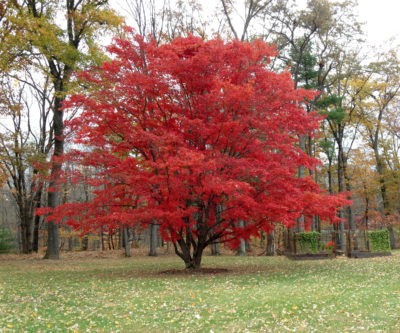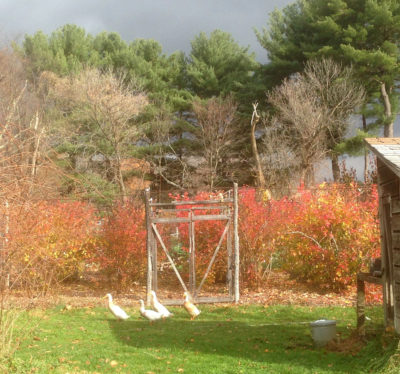Fiery Colors
Colorful Predictions
As leaves are just starting to color up, the question is, “Will the autumn leaf show be good this year?” First off, whether or not it’s good, global warming has pushed showtime forward a bit each year. Around here, the peak of the show used to be the middle of October; nowadays it’s the third week in October.
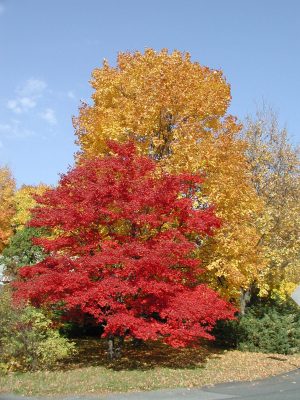
Japanese and sugar maples
Back to predicting how good the show will be this year . . . Throughout summer and into autumn most leaves are, of course, green, which is from chlorophyll. Chlorophyll must be continually synthesized for a leaf to stay green. The shorter days and lowering sun of waning summer are what trigger leaves to stop producing it, letting other pigments lurking there out of hiding.
The yellow and orange colors of leaves are always lurking there, thanks to carotenoid pigments, which help chlorophyll do its job of harvesting sunlight to convert into plant energy. I offer thanks to carotenoids for the especially warm, yellow glow they give to gingko, aspen, hickory, and birch leaves.
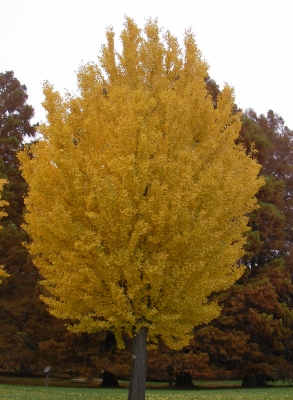
Gingko
Tannins are another pigment, actually metabolic wastes, that all summer are hidden by chlorophyll. Their contribution to the fall palette are the season’s subdued browns, notable in some oaks and enriching the yellow of beeches.
Because leaves harbor carotenoids and tannins all summer long, nothing particular about autumn weather should either intensify or subdue their autumn show. The only glitch could be an early, hard freeze that occurs while leaves are still chock full of chlorophyll. In that case, cell workings come screeching to a halt and all that’s left are frozen, green leaves that eventually drop without any fanfare.
Autumn color also spills out reds and purples, most evident in red maples and some sugar maples, scarlet oak, sourwood, blueberry, and winged euonymus. Those reds and purples come from yet another pigment, anthocyanins. Except for trees like ‘Purple Fountain’ beech and ‘Royal Purple’ smokebush, whose leaves unfold dusky red right from the get go in spring and remain so all season long, in most leaves anthocyanins do not begin to develop until autumn.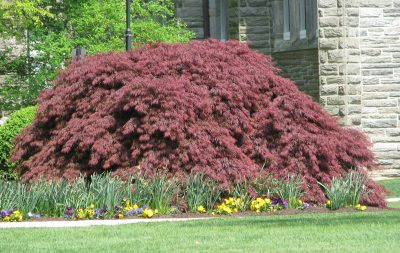
Anthocyanin formation requires sugars, so anything that we or the weather does to promote sugar accumulation in autumn will increase anthocyanin levels in leaves. Ideal weather conditions for sugar accumulation are warm, sunny days to maximize photosynthesis, and cool, but not frigid, nights to minimize nighttime burning up of accumulated sugars.
The many cloudy and rainy days for the past weeks don’t bode well for a great autumn show of leaf color. Less red because less anthocyanin is formed, and any that does form is diluted.
Our Hand in the Color Palette
Weather plays its part in autumn color but we can also have a hand in its development. One way is to ratchet up the reds and purples to make sure that leaves bask in light. I plant a tree where light is adequate (for that species) and, as necessary, prune so that branches don’t shade each other. Street lights don’t count as light, and actually have a negative effect, disrupting the signal that days are getting shorter and it’s time to slow chlorophyll production.
We also can ramp up the autumn show by planting trees genetically programmed for good autumn color. Among the most colorful-leaved trees and shrubs—which, besides those previously mentioned, include goldenrain tree, hickory, ironwood, black tupelo, and fothergilla—individuals within each species might pack a bigger wow than the others. Hence the spicebush variety ‘Rubra’, brick red in fall, or ‘Wright Brothers’ sugar maple, whose leaves become a mottling of gold, pink, orange, and scarlet.
Admittedly, the weather trumps (sorry) all.
(For more about some of the science going on behind the scenes in your garden, and how to put it to practical use, see my new book, The Ever Curious Gardener: Using A Little Natural Science for a Much Better Garden, from which the above is adapted.)
A Brainy Orange
There’s another orange in the garden this autumn, and it’s not in the leaves or the fruit — the hardy orange — about which I recently wrote. It’s the osage orange (Maclura pomifera).
I grew my two trees from seeds extracted from a local osage orange I found on the ground. Each tree is about 25 feet tall and intimidating for their large, mean thorns. Trees are either male or female, so I lucked out, ending up with one of each, allowing the female to bear.
Why would I plant such a tree? For interest: This native of the midwest was, thanks to its thorns, a predecessor of barbed wire for containing livestock; also the primo wood sought after by Native Americans for their bows; and the wood is among the most rot-resistant of any tree.
The softball-sized fruit also is very interesting, with all its convolutions looking something like a green brain. Although related to fig and mulberry, it’s not at all edible. The fruit is claimed, without substantiation, to repel insects and spiders in and around homes.